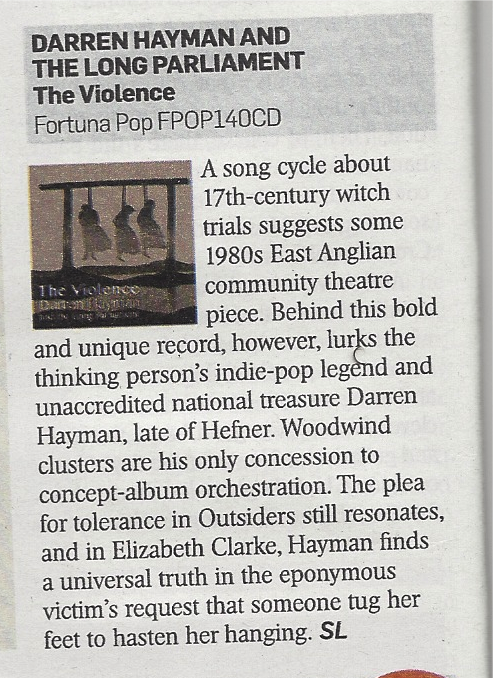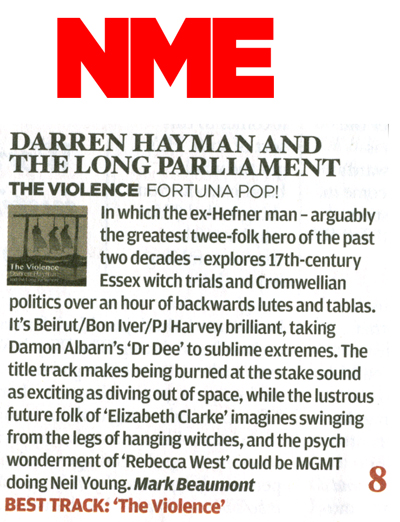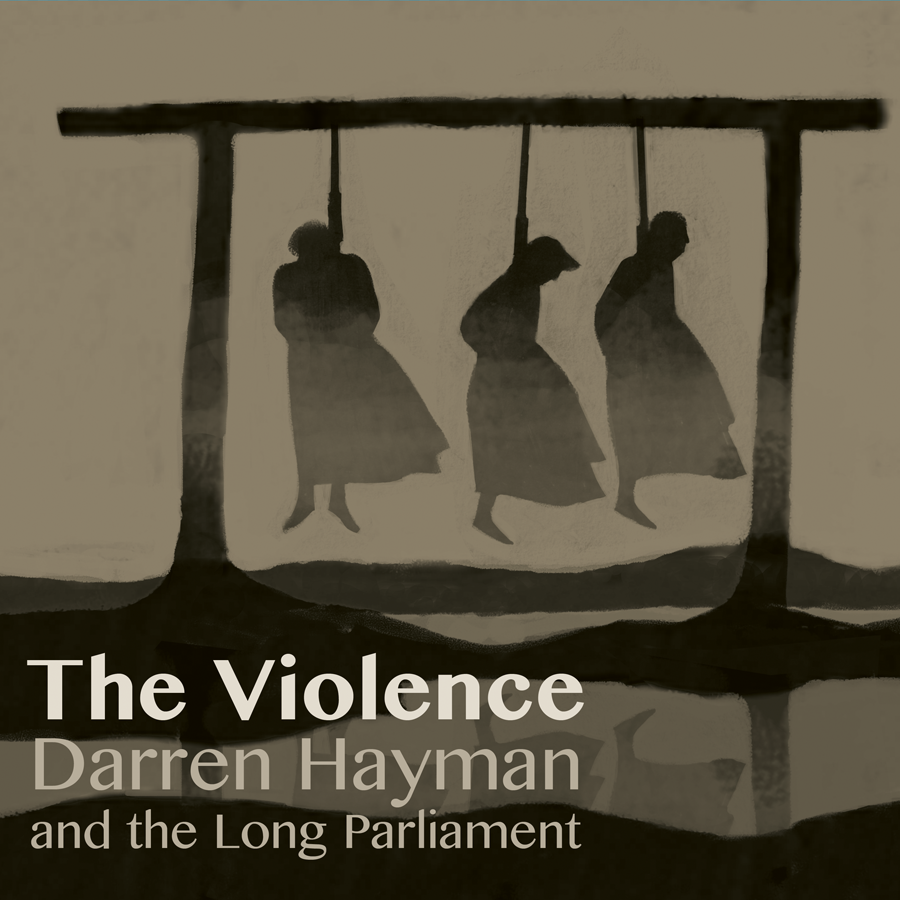I like this podcast/interview with Alexis Petridis on the Guardian Music Weekly. It starts around 34 mins in.
Category: The Violence
The Violence – Further reading suggestions
When putting the sleeve notes together for the violence I gave a lot of thought to including a bibliography. It would be absolutely necessary on a book but seemed a little pompous on a record.
However a few people have asked me what they should read to find out more so I thought I’d put a few of the main texts here.
These are the books I read in full. Other books were required for certain chapters and details but these ones informed the general vision.

God’s Fury, England’s Fire: A New History of the English Civil Wars
by Michael Braddick
Allen Lane
This book is exhaustive and a tough read but is excellent at throwing the 17th Century into context. It spends a lot of time explaining how local government worked for instance.
I found it interesting that, even though I would assume news trickled down to the people slowly, actually there were very few tiers between the beggar and the king.
The title is correct in using the plural as well. We should really always be referring to the English Civil WARS.

The English Civil War: A People’s History
By Diane Purkiss
Harper Collins
This a fantastic book. It’s where I discovered a lot of the themes and even some of the characters found in The Violence. If you were to read just one of these books I would suggest this one. It works hard to make the times personal and tells the story via letters and first person accounts.
It really explains well this fear of the ungodly and the chapter on Matthew Hopkins is one of the best written accounts.
This book is also where I discovered ‘Parliament Joan.’
Witchfinders: A Seventeenth-Century English Tragedy
by Malcolm Gaskill
John Murray
This is adequate as an overview of the witch trials and certainly helped me get events in the right order. The problem is that the author seems to enjoy the subject a little too much.
There’s plenty of accounts about imps and teets (he LOVES the word teets) but little about the reasons for what made the phenomenon come about.
In particular I wanted to found out more about the women who openly confessed and believed themselves to be witches. Something I never got to deal with fully on my record either.
The book was perhaps most helpful in showing me a way I didn’t want to pursue.
The Witchfiner and the Devil’s Darlings
By Simone Peters
Lucas Books
Once again, the title suggests some of the frivolity found within, though in fact its a little drier than the Gaskill book. Includes some interesting song lyrics from the time that will appear on a soon to come companion album of English Civil War folk songs.
The Witch in History: Early Modern and Twentieth-Century Representations.
Diane Purkiss
Routledge
Second entry in the bibliography for the excellent Purkiss. Some of the research is used to give you an overview if not inform specific songs. This book was pivotal in perhaps showing me what tropes to avoid in Witch folk lore.
Historical and Political Ballads and Songs of the Stuart Era
Chris Bennett
A self published book which helped with some of the folk instrumentals on the album and also the sister album of 17th century folk songs that is soon to be released.

The Lore of the Land: A Guide to England’s Legends, from Spring-heeled Jack to the Witches of Warboys
by Jennifer Westwood and Jacqueline Simpson
Penguin
An excellent book which gave me more ideas then I could ever put in to the Violence. I really wanted to do something about the Cunning Men, male ‘witches’ from the Hadleigh area of Essex. Especially as it tied in with the geography of Essex Arms.

A Calendar of Country Customs
Ralph Whitlock
There is only one out take from the Violence, a song called Queen of Misrule which is a close cousin to ‘The Christmas Wars’ on last years Christmas EP. I tried hard but constantly failed to write about Cromwell’s banning of Christmas and the so called ‘wars’ that surrounded them.
Some of the details came from this book.
Sunday Times review from Stewart Lee

NME Review 8/10

Video – The Making of the Violence Part 2
Desire Lines -Free Download from The Violence
The Making of The Violence Part 1 – The Video
The Violence – Uncut Review

Stool Pigeon Review

The Violence

The Violence by Darren Hayman and the Long Parliament
Over the past four years, ex-Hefner man Darren Hayman has been releasing records about lidos, dogging and Russian space dogs. He has played gigs in libraries, observatories and remote Hebridean Islands.
In all that time, however, Hayman’s real focus has been on this, a 20-song, double LP chronicling the 17th century Essex Witch Trials during the English Civil Wars. The record constitutes the third part of Darren’s Essex Trilogy. The previous two albums, Pram Town and Essex Arms, dealt with the new towns and suburbs and the lawless countryside.
“I have been drawn to my birthplace because it is both familiar and alien to me,” says Hayman. “Essex is so close to London yet so remote from it in many ways. I want to be both brutal and tender about the place in my songs. It’s easy to become trapped by your own tropes. I write easily about modernity and pepper my lyrics with slang, brand names and colloquialisms. I wanted to write about something in Essex’s past that spoke of its strangeness and also forced me to write in a language suitable for another period.”
Between 1644 and 1646, approximately 300 women were executed for witchcraft in the eastern counties of Essex, Suffolk and Norfolk. Matthew Hopkins was the self appointed Witch Finder General who travelled East Anglia and helped small communities to rid themselves of these lonely, widowed women.
The album deals with fear and isolation, the way we use our own terror in times of trouble to lash out at the weak. It’s about how societies persecute otherness and outsiders.
The album also concerns itself with the wider context of the English Civil Wars. Hayman sings about King Charles I’s doomed love for his French bride; Parliamentarian spies; Puritan ideals and the comfort of animals.
The album is epic in both concept and sound. The landscape of the Dedham Vale is bought alive by beautiful intricate woodwind scores, trembling strings and destroyed church organs.
The Violence is an outstanding creative achievement, a truly unique and unprecedented album.
“It’s about how violence frightens us and how fear just leads to greater violence,” says Hayman.
Glowing reviews for the Violence…
‘Hayman’s fragile delivery gives voice to the paranoid and persecuted of the past while drawing subtle eerie parallels with modern times. A major work.’ – Mojo – 4 stars.
‘Lustrous future folk and psych wonderment’ – NME 8/10
‘His vision goes far beyond any other current independent artist and is a true treasure’ – Q Magazine
‘All that he does is beautifully thought-out, clever and tuneful and The Violence is no different…diverse, gently melodic and skilfully wrought…lovely, literate, approachable way to approach the past.’ RocknReel 4 stars.
‘Behind this bold and unique record lurks the thinking persons indie-pop legend and unaccredited national treasue Darren Hayman.’ – Stewart Lee – The Sunday Times.
8/10 Uncut Magazine
‘These are wonderful pop songs, each a compacted treasure of melody and heart. Autumnal, witty, sad and very, very English The Violence is the high watermark of Hayman’s career and one of the finest British releases of 2012, a record that neither floats, nor drowns but soars.’ – The Quietus
‘Triumphant’ – Artrocker
Buy Violence on CD


